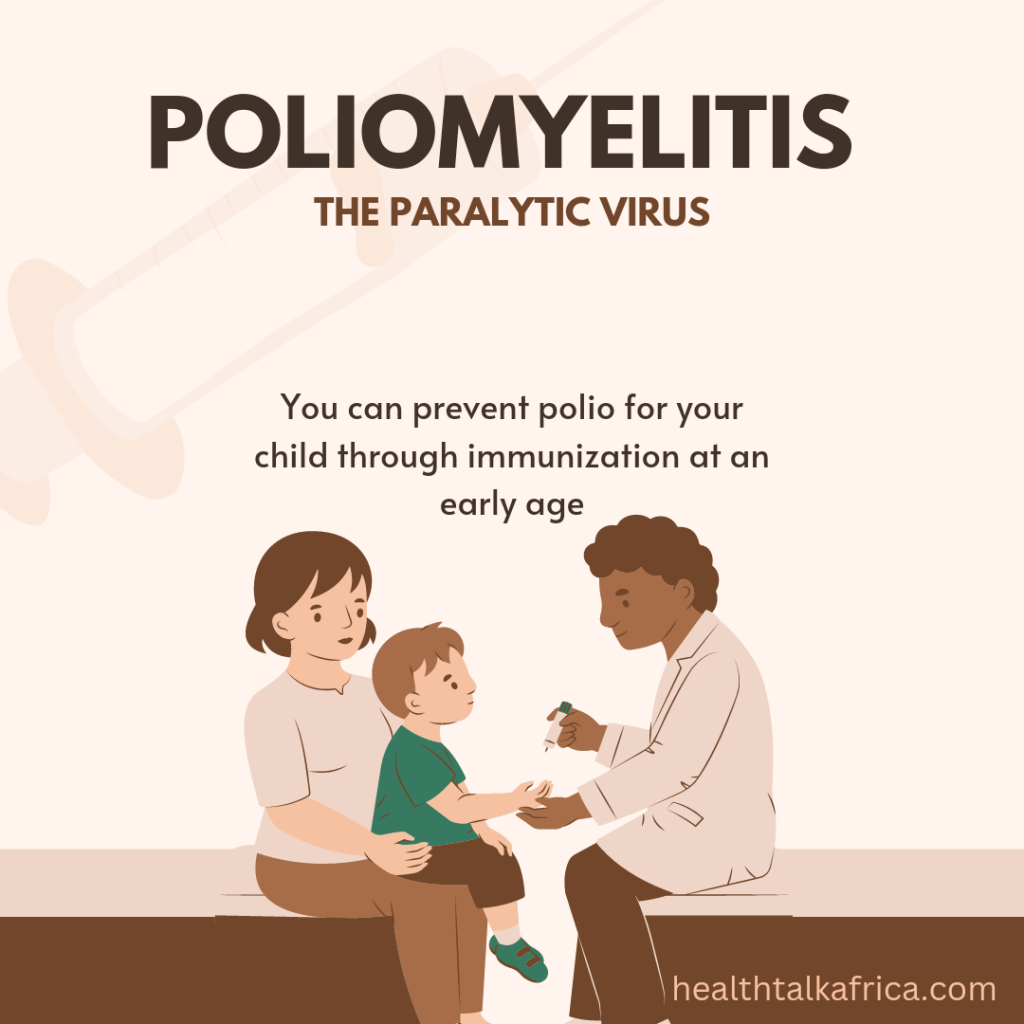Medically reviewed by Joshua Ekpokpobe
As an incurable, disabling and life-threatening disease that can infect a person’s spinal cord causing them to be paralyzed, polio is a sucker of life for infants in the world, but mostly in Africa where most countries are poor and underdeveloped with limited access to primary health care. According to the World Health Organization, polio mostly affect children under the age of 5 years and one in 200 infections leads to paralysis. Among those paralyzed about 5 -10% of them die when their breathing muscles become immobilized. However, efforts by health authorities to eradicate polio has been effective and this is evident in the recent records pushed out by the World Health Organization (WHO) which says that wild poliovirus cases have decreased by over 99% since 1988, from an estimated 350,000 cases in more than 125 endemic countries to just 6 cases reported in 2021. The mainstream prevalent poliovirus is the Circulating Vaccine-Derived Poliovirus type 2 (cVDPV2), for which the total number of cases reported in 2022 is 133 in contrast to 28 recorded cases in 2021. This poliovirus type occurs when the local immunity to poliovirus is low enough to allow prolonged transmission of the original weakened virus in the polio vaccine.

Origins
Polio epidemics began to occur in the late 19th century but scientist believe this disease may have been around for a much longer time. A well-known grave stone from the 18th dynasty of ancient Egypt between 1570 – 1342 BCE depicts a priest with a telltale paralysis and a withering lower right leg and foot. Several other Egyptian mummies depicts similar characteristics. In 1789, Michael Underwood, a pediatrician in London published the first clear description of such a disease occurring in infants. Due to this public awareness, in the early 19th century, small groups of polio-afflicted patients were reported in medical literatures but these were still a few cases. The first true epidemic appeared in the form of an outbreak in Oslo, Norway and northern Sweden where 14 cases and 13 cases were reported respectively. This was followed by 132 cases which erupted in the U.S in 1894. Then, 1,031 cases were reported in Sweden in 1905 and 3,840 cases in 1911 were reported in Stockholm. Thus the spread of poliovirus began and it became publicly known as paralytic virus.
The Vaccine Age
The causal virus of the polio disease, Poliovirus was discovered by a team led by Viennese immunologist and Karl Landsteiner. The antibodies specific to the virus circulating in the blood of infected persons was discovered only after two years. Australian researchers Frank Macfarlane Burnet and Jean Macnamara, who used immunological techniques were able to identify the different serotypes of poliovirus. A team of three, John Enders, Thomas Weller, and Frederick Robbins working at the Harvard Medical School were able to show the virus could be grown in large amounts in tissue culture. Following from there, it would only require a short step to announce in 1953 that the virus killing vaccine had be developed by Jonas Salk from the University of Pittsburgh. The vaccine was termed the Inactivated Poliovirus Vaccine (IPV) or the Salk’s vaccine, it was put to a nationwide test in 1954-55 which included 1.8 million children and was declared a success on April 12, 1955. This vaccine was further administered for the next four years with more than 450 million doses distributed.
Polio Type and Symptoms
Depending on where the virus multiplies and attacks, polio can be divided into;
- Abortive poliomyelitis This type of polio causes a flu-like and intestinal symptoms and it lasts for a few days but does not cause a long-lasting issue.
- Non – paralytic poliomyelitis This disease type may cause a swelling of the area around your brain and may cause several other symptoms like the abortive poliomyelitis which would require one to stay in the hospital
- Paralytic poliomyelitis This type of polio occurs when the virus attacks your brain and spinal cord. It leads to paralysis of the muscles that allow one to breathe, speak, swallow and move limbs. Less than 1% of people with polio get paralytic poliomyelitis.
- Polioencephalitis This type of polio that mostly affects infants and it causes brain swelling, anxiety, seizures, but this polio type is rare.
- Post – polio syndrome This type of polio occurs when symptoms of polio come back years after a polio infection.
General Symptoms
While most people with poliovirus will not have any visible symptoms, about 1 of 4 people with the infection will have a flu-like symptoms which include:
- Sore throat
- Fever
- Tiredness
- Nausea
- Headache
- Stomach pain
Transmission
Polio is a very contagious disease and can spread through person-to-person contact, it can contaminate food and water in unsanitary conditions. Poliovirus enters the body through the mouth and spreads through;
- Contact with feces (poop) of an infected person
- Droplets from a sneeze or cough of an infected person (less common)
An infected person can spread the virus to others immediately before and up to 2 weeks after symptoms appear. The virus can live in an infected person’s intestines for many weeks and it can contaminate food and water in unsanitary conditions.
Diagnosis
Polio can be diagnosed by performing physical exams, testing samples of body fluids and asking you about your symptoms. Samples of body fluids collected for polio infections include;
- Saliva from throat
- Poop
- Blood
- Cerebrospinal fluid
Treatment
There is currently no cure for paralytic polio and no specific treatment either, but physical therapy can help with arm or leg weakness and might improve long term outcomes especially if implemented early in the course of illness. One could also do the following to improve symptoms;
- Drinking fluids (Such as water, juice and broth)
- Using heat packs to help muscles aches
- Taking pain relievers like ibuprofen
- Getting rest.
Prevention
Prevention of polio disease is with the polio vaccine, there are two types of vaccines that can prevent polio;
- Inactivated poliovirus vaccine (IPV) This the type of vaccine that is given In the leg or arm, depending on the patients age. This vaccine contains a polio virus that’s been treated (Killed), so it can’t multiply anymore
- Oral poliovirus vaccine (OPV) This is the predominant vaccine used in the fight to eradicate polio. This type of vaccine use a live virus that’s been weakened, so it shouldn’t make one sick. Although even though the virus is weakened, there still exist a small risk of 1 in 2.5 million people still getting sick from OPV. OPV can change or mutate and spread from person to person like naturally occurring polio (Vaccine-derived poliovirus).
It’s important to get your kids vaccinated against polio from an early age to prevent them from having poliomyelitis: the paralytic virus. Although vaccination has eliminated polio in many parts of the world, efforts are still being made to completely eradicate the disease and it’s residue. As long as polio still exist in any part of the world, it can come back and cause more harm to those, especially infants who have not been vaccinated.
